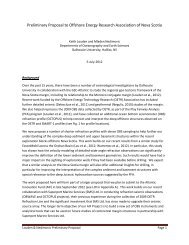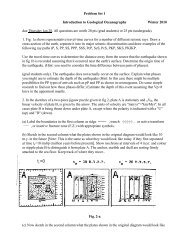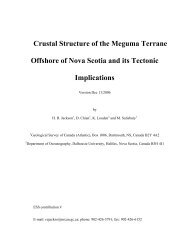the stratigraphy and structural history of the mesozoic and cenozoic ...
the stratigraphy and structural history of the mesozoic and cenozoic ...
the stratigraphy and structural history of the mesozoic and cenozoic ...
Create successful ePaper yourself
Turn your PDF publications into a flip-book with our unique Google optimized e-Paper software.
By <strong>the</strong> latest Triassic, <strong>the</strong> North American <strong>and</strong> African plates in <strong>the</strong> Scotian<br />
region had drifted northward to approximately 10-20º paleo-latitude, a relatively arid sub-<br />
equatorial climatic zone (Kidston et. al, 2002). Renewed rifting to <strong>the</strong> north in <strong>the</strong> Gr<strong>and</strong><br />
Banks/ Iberia area breached topographic barriers to <strong>the</strong> proto-Atlantic ocean <strong>and</strong><br />
permitted <strong>the</strong> first incursion <strong>of</strong> marine waters from <strong>the</strong> Tethys oceanic realm to flood <strong>the</strong><br />
interconnected syn-rift basins. Restricted shallow marine conditions were established at<br />
this time. Due to <strong>the</strong> hot dry climate <strong>and</strong> sub-sea level elevation, <strong>the</strong>se waters were<br />
repeatedly evaporated, resulting in <strong>the</strong> accumulation <strong>of</strong> extensive salt <strong>and</strong> anhydrite<br />
deposits <strong>of</strong> <strong>the</strong> Argo Formation. Estimations on <strong>the</strong> thickness <strong>of</strong> <strong>the</strong> Argo Formation<br />
range from two kilometers thick in central rift sub-basins (Kidston et. al, 2002) to in<br />
excess <strong>of</strong> five kilometers in parts <strong>of</strong> <strong>the</strong> Orpheus Graben <strong>and</strong> Abenaki Subbasin<br />
(MacLean <strong>and</strong> Wade, 1992). The Argo Formation overlies <strong>the</strong> Eurydice Formation in <strong>the</strong><br />
basin center <strong>and</strong> interfingers with it near basin margins (MacLean <strong>and</strong> Wade, 1992).<br />
Renewed tectonism during <strong>the</strong> Sinemurian resulted in complex faulting <strong>and</strong> some<br />
erosion <strong>of</strong> Late Triassic <strong>and</strong> Early Jurassic sediments <strong>and</strong> older rocks (Wade <strong>and</strong><br />
MacLean, 1990). This phase <strong>of</strong> erosion is known as <strong>the</strong> Break-Up Unconformity (BU)<br />
<strong>and</strong> marks a time <strong>of</strong> tectonic adjustment related to plate separation <strong>and</strong> associated ocean<br />
spreading. Within <strong>the</strong> study area <strong>the</strong> Breakup Unconformity forms an easily mappable<br />
seismic horizon that marks <strong>the</strong> top <strong>of</strong> Late Triassic-Early Jurassic synrift strata. The<br />
southwest-nor<strong>the</strong>ast trending series <strong>of</strong> platforms, ridges, <strong>and</strong> depocenters that were<br />
created on <strong>the</strong> Nova Scotia margin as a result <strong>of</strong> <strong>the</strong> Sinemurian breakup are defined by<br />
24









